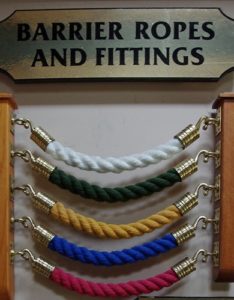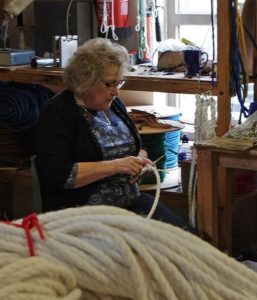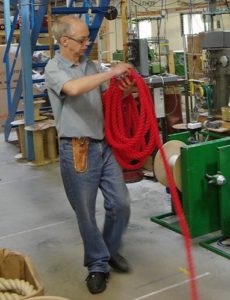A century ago, rope makers were common throughout Britain. Now they are only remembered in road names like Ropery or Ropewalk. Ropes have been made in Hawes for nearly 200 years and a rope maker is still working in the village. Ropes are still made traditionally by hand as well as by machine. Employing twenty two people it makes everything from shoe laces to bells ropes, clothes lines to dog leads. It makes a fascinating visit.
Over the years the premises have grown. The shop is in the original workshop and sells a wide range of products made on site. Dog leads are the most popular item. Next to it is a room full of winding machines, which were spinning too fast to photograph. Lead ropes for horses and cattle halters are still made in here, as well as skipping ropes.
Past the office is the large braiding room where spinning reels of different colours ‘knit’ long thin braids suitable for shoe laces, wicks for candles and handles for paper carrier bags.
Beyond is a small room full of fast turning winding machines where the yarn is wound onto bobbins. At the far end of the building is a small room with a short video. Unlike so many videos this is actually worth watching with a lot of information about rope making. Display boards have information about barrier ropes and fittings and the making and finishing of wicks for candles. There is more to candle wicks than meets the eye. The trick is to make a wick that stands above the wax as the candle burns down. The wicks are specially treated to control the rate of burning. The wick also needs to be the correct diameter for the size of candle.
Across a bridge, with lovely views down the valley, is the new factory added in 1992. In the centre is the new rope walk which allows ropes up to 25m in length to be made. These ropes are thicker and heavier than those made in the original building and are suitable for bannisters, barrier and bell ropes. This is a fascinating process to watch.
The strands of yarn are run up and down the length of the walk. If a longer rope is needed, the doors at the far end of the rope walk can be opened. An initial twist just separates the individual strands. These strands are then twisted together using a piece of wood to stop them getting tangled. As strands are twisted, the rope gets shorter and thicker. When this is finished, the rope is rolled and stored. Coloured ropes are usually made from synthetic polypropylene rather than flax. The rope is cut to length and ladies finish off the ends by hand. This involves knotting the rope and adding brass or chrome fittings and a ring. Bannister ropes usually have a decorative ‘rose knot’ on the ends.
Also in this building is the dog lead section where dog leads, collars and accessories are assembled for dispatch. These are in a range of bright colours and designs.
Entry is free and the Ropeworks is open Monday – Friday 9-5. The shop is open on Saturdays in July and August. This is a fascinating and worthwhile place to visit.
There are public toilets including disabled in the car park. There are plenty of eating places in Hawse.
DISABLED ACCESS
There is no parking by the Ropemakers, but there is a public car park in the old station yard just a short walk away. This cost £2.50 for two hours. With a blue badge, you get three hours.
There are steps into the shop but disabled access is signed across a bridge on the road from the car park. There is level access throughout the Ropeworks and plenty of space for wheelchairs. It is possible to watch all the operations. When I visited there were two people with mobility scooters who had no problems accessing any part of the buildings.










